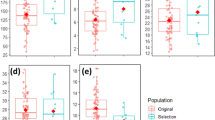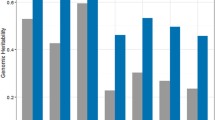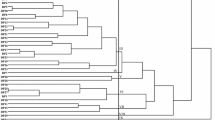Summary
A study was conducted on the segregating populations from tenera × tenera, tenera x fertile Pisifera crosses and tenera selfings. Pisifera palms were categorised as (1) fertile Pisifera palms if producing mature ripe bunches regularly under natural conditions, and (2) partially female sterile pisifera palms if producing a few or no bunches in several years.
Based on observations on the segregation patterns of the fruit forms (dura, tenera and pisifera) and bunch production patterns, a genetic model was formulated to explain the genetic basis of fertility in the oil palm. Fertility in the oil palm is shown to be controlled by a single gene which is linked to the gene controlling fruit form. Chi-square tests confirmed that the model agreed with the segregating ratios of fruit form and fertility observed.
The implications of this finding with regard to oil palm breeding and improvement, and the potential of the fertile pisifera palm for increasing palm oil yields in plantations are discussed.
Similar content being viewed by others
References
Arasu, N. T., 1970. A note on the germination of pisifera (Shell-less) oil palm seeds. Malay. agric. J. 47: 524–527.
Beirnaert, A. & R. Vanderweyen, 1941. Contribution à l'étude génétique et biométrique des variétés d'Elaies guineensis Jacq. Publs. Inst. natn. Étude agron. Conge belge. Série Scinetifique 27, 101 p.
Chin, C. W., 1981. Segregation of fertility, fruit forms and early yield performance of selected sibbed and outcrossed fertile pisifera progenies. Proceedings of the International Oil Palm Conference, Kuala Lumpur, Malaysia.
Gascon, J. P., 1956. Études sur les pisifera et les croisements dura et pisifera. Bull. Agron. Inst. natn. Étude agron. Congo belge 14: 48–57.
Obasola, C. O., 1974. Pisifera investigation. Annual Report (1974–1975) NIFOR, Benin City, Nigerai. 37 pp.
Sparnaaij, L. D., 1960. The analysis of bunch production in the oil palm. J. W. Afr. Inst. Oil Palm Res. 3 (10): 109–180.
Sparnaaij, L. D., 1969. Oil palm (Elaeis guineensis Jacq.) In: F. P. Ferwerda & F. Wit (Eds), Outlines of perennial crop breeding in the tropics. Miscellaneous PapersLandbouwhogeschool, Wageningen, No. 4, pp. 339–387. Veenman, Wageningen.
Thomas, R. L. & J. J. Hardon, 1968. An outline of breeding and selection in the oil palm. Malays. agric. J. 46: 324–331.
Wonkyi-Appiah, J. B., 1973. Germination of pisifera oil palm seeds under plantation conditions. Ghana J. Agric. Sci. 6: 223–226.
Wonkyi-Appiah, J. B., 1975. Fertility and germination in pisifera oil palm. Ghana J. agric. Sci. 8: 85–88.
Wonkyi-Appiah, J. B. 1980. Exploitation of the fertile pisifera palm to increase palm oil yield in oil palm plantations. Paper presented at the 12th Biennial Conference of the West African Science Association, Univ. of Ife, Ile Ife, Nigeria (Mimeo).
Author information
Authors and Affiliations
Rights and permissions
About this article
Cite this article
Wonkyi-Appiah, J.B. Genetic control of fertility in the oil palm (Elaeis guineensis Jacq.). Euphytica 36, 505–511 (1987). https://doi.org/10.1007/BF00041494
Received:
Issue Date:
DOI: https://doi.org/10.1007/BF00041494




